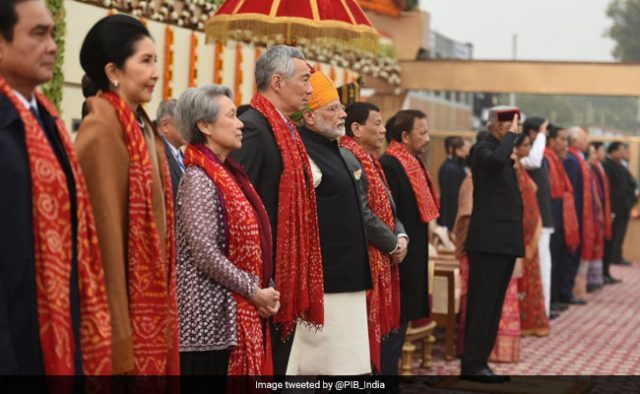
The Republic Day diplomacy has challenged the China-centric Asian order. Although India alone can’t take on China, once more partners come together, Chinese hegemony would surely take a beating. Myanmar desperately wants to get rid of the Chinese clutch. If Singapore comes to help, Myanmar’s dependence on Beijing will taper off. Therefore, it needs combined efforts. Modi’s diplomacy has the potential to create a new order in Asia
The 69th Republic Day has been starkly different from previous ones for two reasons: a) for the first time, multiple chief guests graced the occasion; b) the Narendra Modi Government made concerted efforts to turn the august gathering of ASEAN heads of Governments/states into an opportunity to explore possibility of a new Asian Order conducive to India’s economic and strategic interests.
Prime Minister Narendra Modi brought together 10 ASEAN heads of the states with an aim to set up new benchmark for symbiotic growth. As Modi tweeted “shared values, common destiny free from contest and claims are the focal points of this meeting”, the jubilations seen among the guests were spectacular. The PM’s call for “a common vision for the future, built on commitment to inclusion and integration, belief in sovereign equality of all nations irrespective of size, and support for free and open pathways of commerce and engagement,” kills two birds with one stone. While it is for India and ASEAN countries’ robust future, at the same time it tries to strike a blow to China’s imperial designs. India had been a reluctant power. But with beginning of the Modi Era, the reluctance is on the wane as aspiration for a strong India, at least in Asian context, has thrived. The way the Doklam stand-off was resolved was a flashpoint. This led to a belief among many South East countries that India could be the best partner to balance the Dragon.
Throughout the Cold War, the US setting in the South East Asia was based on the ideological designing. America set up a group of nations under its military umbrella to contain Communist influence. The US tried to save Vietnam, Cambodia and Laos from falling into the trap of China. China’s overstepping in the region created a “one-way traffic”: less trade, but more fear evolved in the region. That is when most of the ASEAN countries started looking at India to come forward not merely to checkmate the encroaching China, but to secure and accelerate the trade and security of their countries. Grabbing the opportunity, Modi defined his Look Act Policy during the 12th India-ASEAN summit in Myanmar in 2014, where he explained to take the joint venture beyond military and strategic calculus.
India and the ASEAN share the same concern on the issue of China’s hegemony in the South China Sea. However, the ASEAN has failed to put up a joint front against China’s illegal construction of artificial islands in the South China Sea. In this context, Modi said from ASEAN forum, “India assures the ASEAN of its steady support towards achieving a rule-based regional security architecture that best attests to the region’s interests and its peaceful development.”
India’s outreach comes at a time when China is trying to reinforce its military, economic and political hold in South East Asia and beyond. India’s recent “quad” meeting envisages a better plan for the region. The US, along with Japan, is also keen to see India as an important power in South East Asia and Pacific.
Tourism is another area where India and the ASEAN nations find common interests. The Delhi Declaration underlines specific concern about cross-border terrorism and freedom of navigation that commits them to an early implementation of various agreed projects, including their Plan of Action 2016-2020. Efforts are on to further strengthened people-to-people relationship with India’s seven North-Eastern States and the ASEAN countries.
The ASEAN countries have no territorial or maritime dispute with Indian and they view New Delhi as non-expansionist power. It is the attractive proposition for them. But all is not smooth. There are many challenges. India does not enjoy robust relation with all of the ASEAN countries. There are different sets of interests among the ASEAN countries. Priorities are guided by the country’s strategic interests and bilateral ties. There is no consensus among the ASEAN countries on what is expected from India in terms of a political or security role. For example, while Singapore, Vietnam and Myanmar are supportive of a stronger Indian security presence in the region, Malaysia and Indonesia are not interested in it. Thailand and Indonesia maintain that the security of the Malacca Straits must lie primarily with the littoral states. Moreover, Laos and Cambodia are closer to China, and they are not excited about India’s larger role in the region.
Second, trade between China and the ASEAN countries are much larger in comparison to India. While China-ASEAN trade accounts 15.2 per cent of the bloc’s total trade, its trade with India only is just 2.6 per cent. For India, it is not possible to match with the Chinese feat because of the Dragon’s geographical advantage. The real challenge for India is meeting its own targets. On trade, it is nowhere near reaching the goal of $200 billion by 2020. Connectivity projects with the ASEAN countries, like the trilateral highway to Thailand via Myanmar, are years behind its schedule. Chinese outreach in South East Asia is wider due to its early entry. China enjoys the biggest industrial supply chain in the region.
In this perspective, the Republic Day diplomacy has evolved new ideas. Modi has been trying to woo the ASEAN nations by saying that India looks to the east for morning light and fresh ideas to begin with his/her day. He meant to say that there are a number of common grounds and a strong platform for synergies to build a common prosperous future. The China-centric Asian order has been challenged by the smart diplomacy. As India is aware of its geographical location; it may not be able to compete against China alone. But once more partners come together, Chinese hegemony could be challenged. Myanmar is one the ASEAN countries which desperately wants to get rid of the Chinese clutch. If Singapore, along with other South Asian countries, is willing to invest in Myanmar, its acute dependence on China will taper off soon. Therefore, it needs combined efforts. Modi’s Republic Day diplomacy has succeeded in creating viable joint ventures together with the ASEAN countries. It has the potential to create a new Asian World Order.
By Satish Kumar
(The writer is Head of the Department of Political Science, Central University of Haryana)














